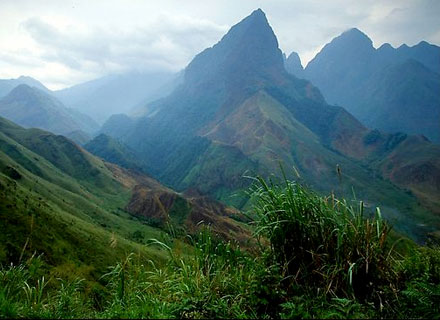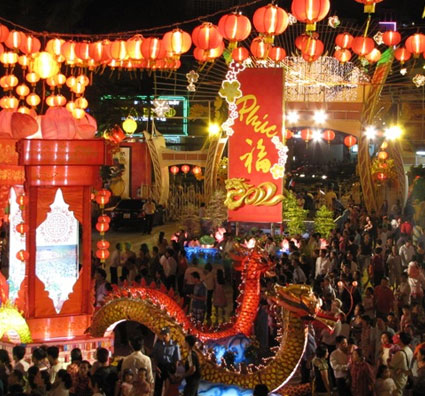Vietnam
Country statistics

Land area: 125,622 sq miles (325,361 sq km)
Total area: 127,244 sq miles (329,560 sq km)
Population (2010 est.): 89,571,130 (growth rate: 1.0%); birth rate: 17.3/1000; infant mortality rate: 21.5/1000; life expectancy: 71.9; density per sq miles: 679
Capital City: Hanoi
Monetary unit: Dong
Languages: Vietnamese (official); English (increasingly favored as a second language); some French, Chinese, Khmer; mountain area languages (Mon-Khmer and Malayo-Polynesian)
Ethnicity/race: Kinh (Viet) 86.2%, Tay 1.9%, Thai 1.7%, Muong 1.5%, Khome 1.4%, Hoa 1.1%, Nun 1.1%, Hmong 1%, others 4.1% (1999)
Religions: Buddhist 9%, Catholic 7%, Hoa Hao 2%, Cao Dai 1%, Protestant, Islam, none 81%
Country introduction

Vietnam is located in South-east Asia along the South China Sea. The country is bordered by China, Laos, and Cambodia, and for the most part is separated from them by a long chain of mountains.
Vietnam is a country of tropical lowlands, hills, and densely forested highlands, with level land covering no more than 20% of the area. Three quarters of Vietnam is made up of mountains and hills. In the north, there is the Hoang Lien Mountains which contains the highest point in Vietnam, Fansipan, extending 3,143 m (10,312 ft) into the sky.
The country can be divided into four geographical regions: the highlands and the Red River Delta in the north, the Truong Son Mountains form the Central Highlands running almost the full length of Vietnam along its borders with Laos and Cambodia, the coastal lowlands, and the Mekong River Delta in the south.
The Red River and the Mekong River are navigable in their entirety and are considered to be the two major rivers in Vietnam. To help prevent flooding in their deltas, a system of dikes and canals have been built which confines the rivers to their paths. However, silt carried by the Red River and its tributaries has raised the level of the river beds above that of the surrounding plains and breaks in the levees result in disastrous flooding every year during the monsoon season.
The culture

Vietnam has 54 groups living together in the country. Each group has unique cultural features, contributing to form Vietnamese culture that is united in variety. Beside the typical Viet-Muong culture, there are others special cultural groups such as Ta-Nung, Thai, Cham, Hoa-Ngai, Mon-Khmer, H'mong- Dao. Especially, the culture of Tay Nguyen ethnic groups has remained various and perfect traditions of a merely agriculture society which sticks to natural forests and mountains.
Spiritual life in Vietnam is a grand panoply of belief systems, including Confucianism, Taoism, Buddhism, Christianity, and Tam Giao (literally 'triple religion'), which is a blend of Taoism, popular Chinese beliefs, and ancient Vietnamese animism.
The most important festival of the year is Tết Nguyên Đán or Tết, a week-long event in late January or early February that heralds the new lunar year and the advent of spring. Celebration consists of both raucous festivity (fireworks, drums, gongs) and quiet meditation. In addition to Tết, there are about twenty other traditional and religious festivals each year.
As a language, Vietnamese is exceptionally flexible and lyrical, and poetry plays a strong role in both literature and the performing arts. Folk art, which flourished before French colonization, has experienced a resurgence in beautiful woodcuts, village painting, and block printing. Vietnamese lacquer art, another traditional medium, is commonly held to be the most original and sophisticated in the world. Music, dance, and puppetry, including the uniquely Vietnamese water puppetry, are also mainstays of the country's culture.
Although rice is the foundation of the Vietnamese diet, the country's cuisine is anything but bland. Deeply influenced by the national cuisines of France, China, and Thailand, Vietnamese cooking is highly innovative and makes extensive use of fresh herbs, including lemon grass, basil, coriander, parsley, laksa leaf, lime, and chili. Soup is served at almost every meal, and snacks include spring rolls and rice pancakes. The national condiment is nuoc mam, a piquant fermented fish sauce served with every meal. Indigenous tropical fruits include bananas, pineapples, coconuts, lychees, melons, mandarin oranges, grapes, and exotic varieties like the three-seeded cherry and the green dragon fruit.
Attractions & landmarks

Hanoi has made a name for itself due to the popular 'Towers of Hanoi' puzzle. The Tower of Hanoi (sometimes referred to as the Tower of Brahma or the End of the World Puzzle) was invented by the French mathematician, Edouard Lucas, in 1883. He was inspired by a legend that told of a Hindu temple where the pyramid puzzle might have been used for the mental discipline of young priests. Legend said that at the beginning of time the priests in the temple were given a stack of 64 gold disks, each one a little smaller than the one beneath it. Their assignment was to transfer the 64 disks from one of the three poles to another, with one important provisonal that the large disk could never be placed on top of a smaller one. It is prophesised that if the monks ever placed the last disc the temple would crumble to dust and the world would end. However, this is something we shouldn't worry about because even if the monks could move a disk every second it would take them 36 billion years to complete their sacred duty. As well as this somewhat colourful legend, Hanoi has plenty to offer tourists with plenty of public parks, bustling markets, busy nightlife and of course the ubiquitous ancient monuments and temples. Of particular interest are the One Pillar Pagoda and the Van Mieu temple of literature.
Ho Chi Minh City or Saigon is the nation's largest city. It is a centre of business, economics and culture and is definitely one of the best cities to visit in the country. Must see attractions include the foreboding Notre Dame Cathedral (not to be confused with the one in France), the Reunification Palace and the War Remnants Museum. Of particular importance is the Giac Lam Pagoda, set in Dam Sen tourist park. This temple was a religious centre during the 19th century and now boasts a mini-museum of religious and cultural artefacts. While in the city tourists should also visit the Ben Thanh market where souvenirs can be picked up for cheap.
The city of Dalat is becoming a more popular destination, especially with honey-mooners due to its relaxed, peaceful and tranquil setting. It is often quoted as being the most beautiful city in Vietnam and is an excellent base for exploring the largely unspoilt highland areas. Within the city itself visitors will find the magnificent Bao Dai's Summer Palace. This impressive structure also houses displays of interesting Vietnemese art and artefacts. Some visitors can choose to visit some of the more offbeat attractions such as the carnavalistic Valley of Love or the Chicken Village. Dalat is also renowned for its excellent café culture which should definitely be sampled before leaving the area.